"Of flowers, garland, love-knots, silly posies, groves, meadows, melodies, and arbour roses; my kingdom's at its death, and just it is that I should die with it."
Wilfred Owen, the Great War poet, wrote to his mother that he was going to war to defend the language of Keats. Of course, the World Wars were about much more English or German dominance, and Owen demonstrates as much in his consciousness-rendering poetry.
Like Keats, Wilfred Owen died extraordinarily young and challenged the establishment to stop glorifying war. It is a pleasure to live in a country that, for the most part, resuscitates its treasures, even if it disagrees with them (or pilfered them).
A few weeks ago, I was treasure-hunting in an antiquarian bookshop and found a beautiful copy of Keats's work, published in 1897 with plates by architect Robert Anning Bell. I thought, 'Is this the version Owen owned and read?'
I bought it immediately and am excited to share a few of the exquisite plates.
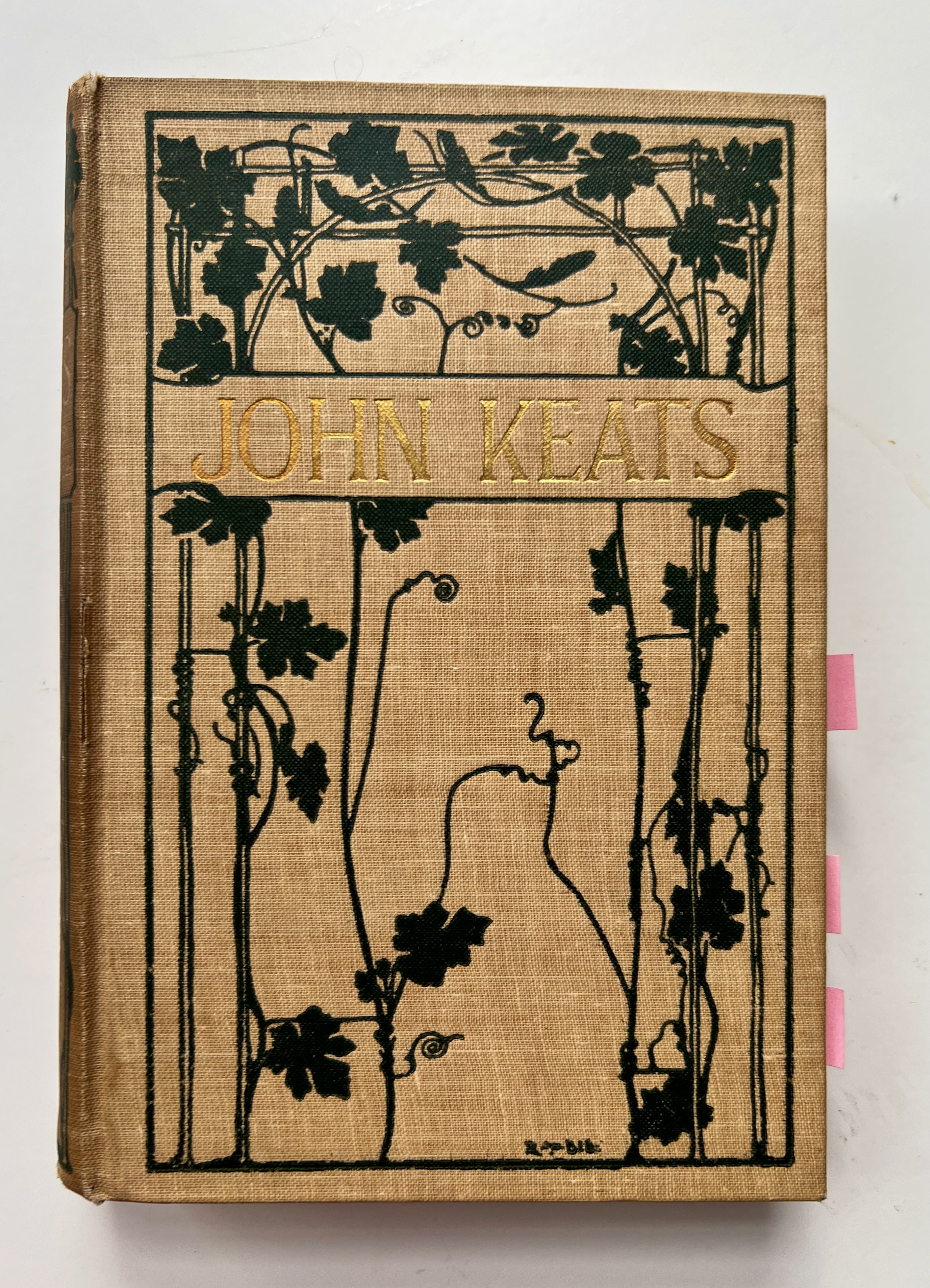
Maya Angelou wrote something that has stayed with me for years: some artists belong to all time, to all people. Certainly, Angelou, in her abundant memoirs of pain forgiveness, exemplifies that universal artist. So does John Keats (October 31, 1795 – February 23, 1821). Not simply for his modern poetic structure but for his personal life. He lived and wrote pain and pleasure together in a vastly accessible way, certainly to Owen and his contemporaries.
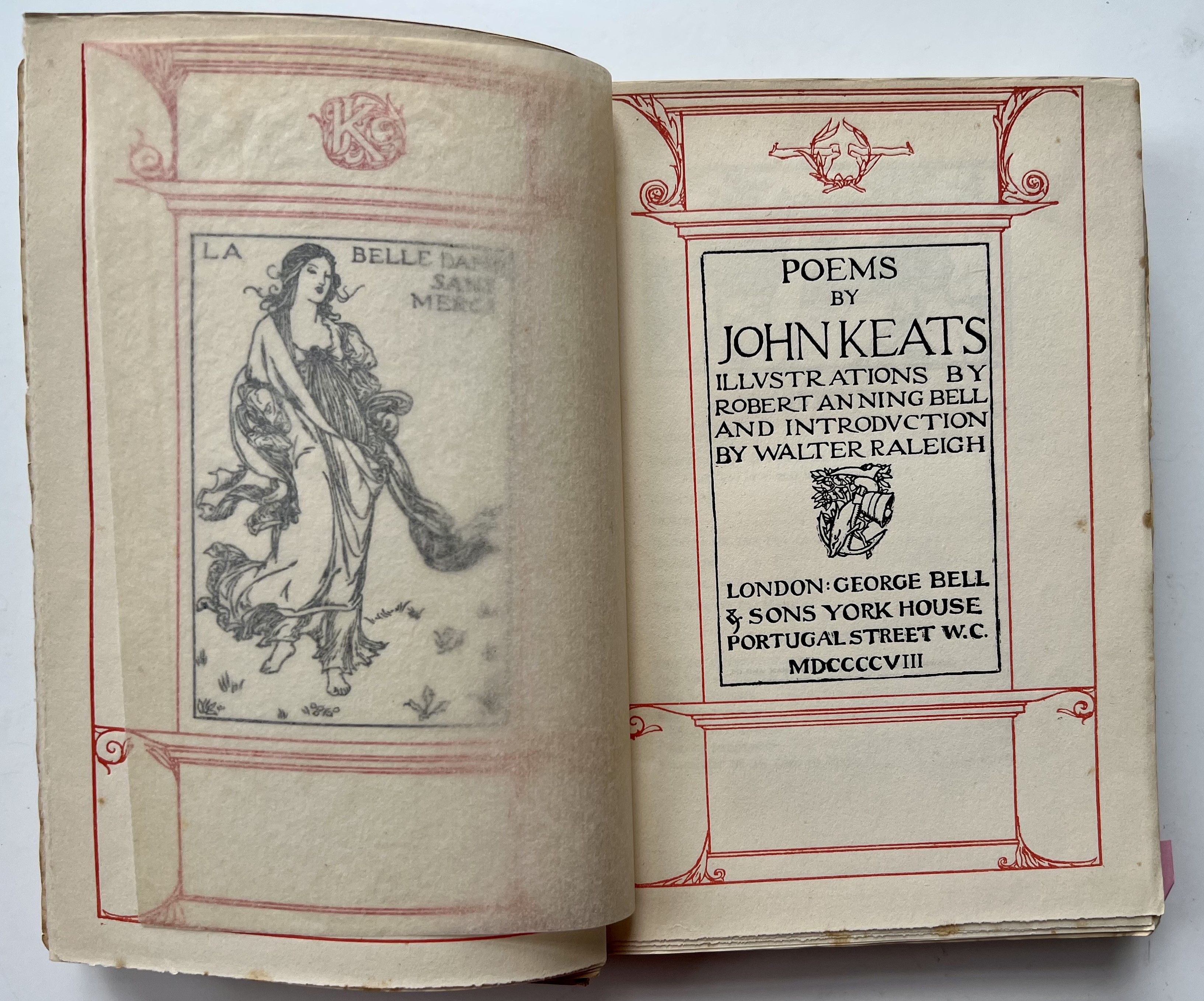
Keats might speak to the ages now, but his first publication was so poorly received it almost broke his tentative poetic aspirations. He trained and qualified as a medical surgeon and apothecary, but in 1816, he abandoned that career path to write poetry. Keats's family was not financially established; his father had died when John was eight, and his mother when John was fourteen from tuberculosis, the illness that would also kill his brother and the poet himself.
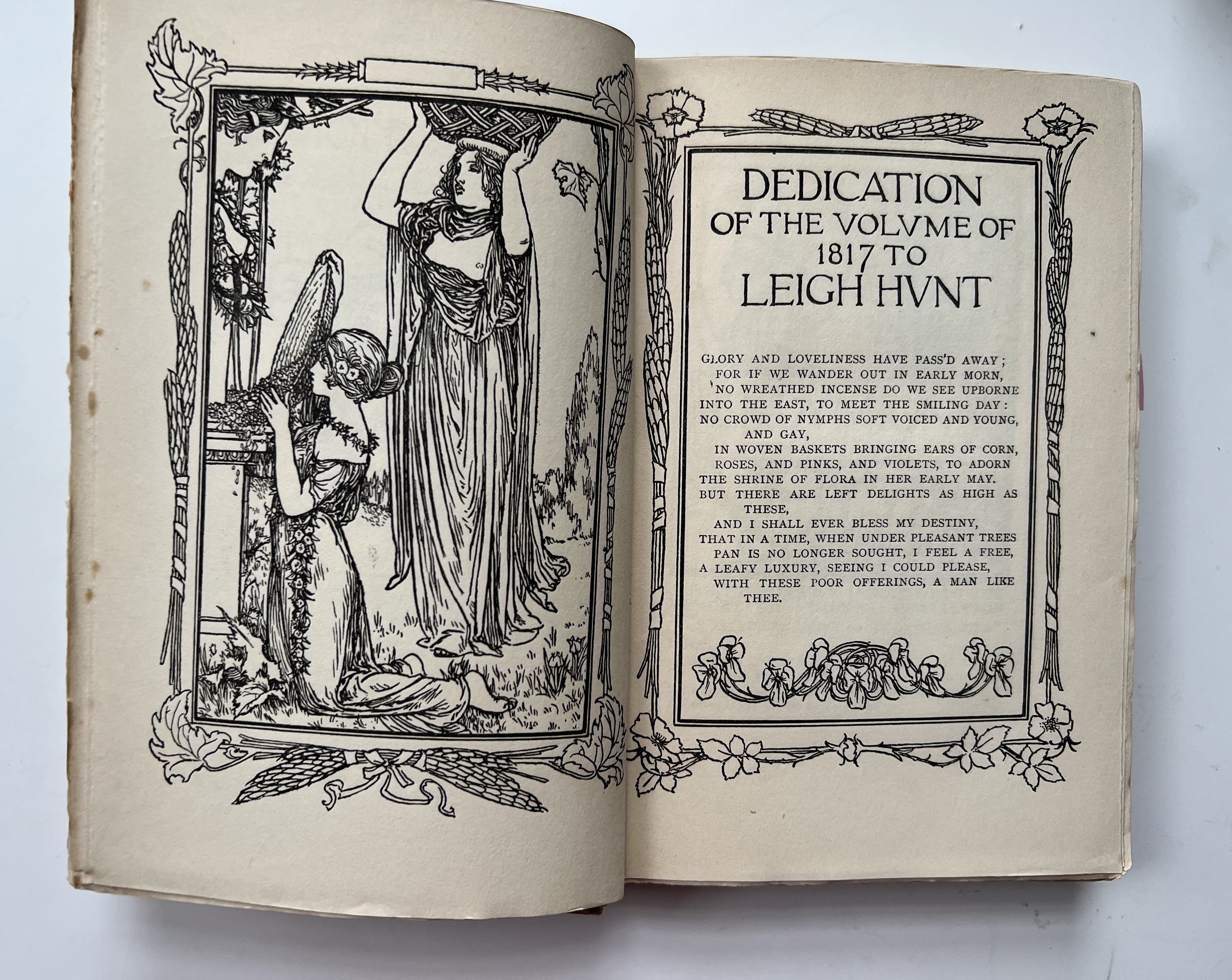
Fortunately, the support of his Romantic movement elders roped him into poetry full-time (although Keats expressed interest in returning to medicine as late as 1819.) Keats' first poem, "O Solitude," was published in 1816 in Leigh Hunt's The Examiner. Hunt was many things but was best known for this "radical" magazine, which first published Keats, Lord Byron, and Percy Bysshe Shelley. He gave these outsiders an audience and exposure. In return, Keats dedicated his work to Hunt:
Glory and loveliness have pass'd away;
For if we wander out in early morn,
No wreathed incense do we see upborne
Into the east, to meet the smiling day:
No crowd of nymphs soft voice and young, and gay
In woven baskets bringing ears of corn,
Roses, and pinks, and violets, to adorn
The shrine of flower in her early May.
But there are left delights as high as these,
And I shall ever bless my destiny,
That in a time, when under pleasant trees
Pan is no longer sought, I feel a free,
A leafy luxury, seeing I could please,
With these poor offerings, a man like thee.
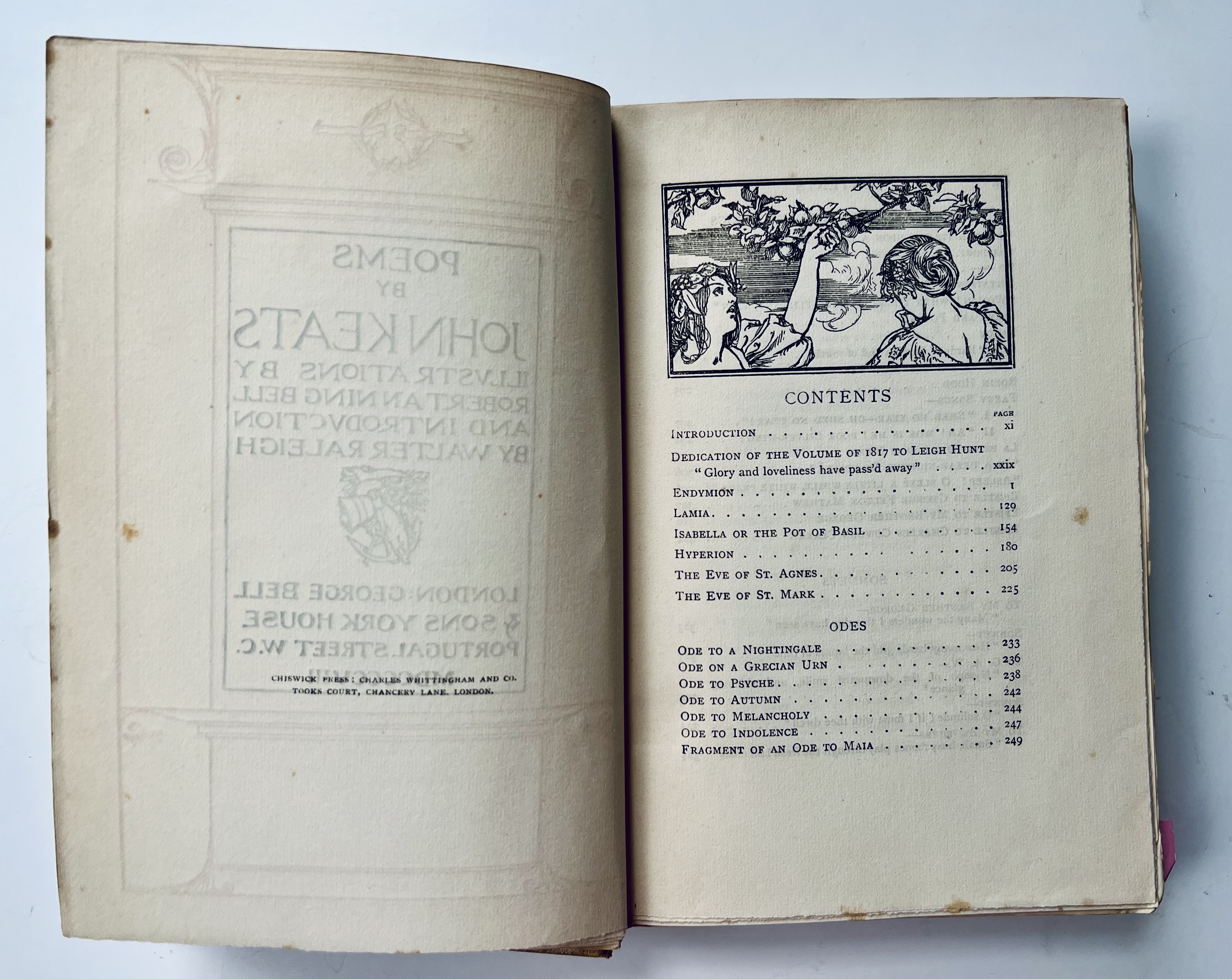
While his supporters were encouraging, the establishment critics did not receive " O Solitude " well. Keats kept writing, took a few walking holidays, and made social connections, including Charles Brown, in whose house Keats lived and worked.
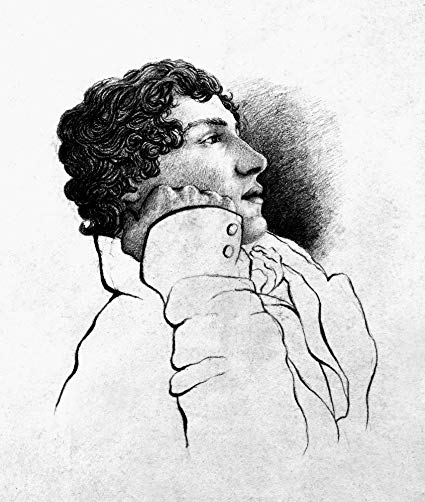 Charles Brown's pencil portrait of his friend John Keats, 1819.
Charles Brown's pencil portrait of his friend John Keats, 1819.In 1818, Keats published his poem Endymion, a mythological human who was cursed by the gods to pass his life in sleep. It was Keats's longest poem, his most autobiographical, and was detested by critics. Keats' most famous lines are contained herein:
A thing of beauty is a joy forever,
Its loveliness increases; it will never
Pass into nothingness, but still will keep
A bower quiet for us, and a sleep
Full of sweet dreams, and health, and quiet breathing.From "Endymion"
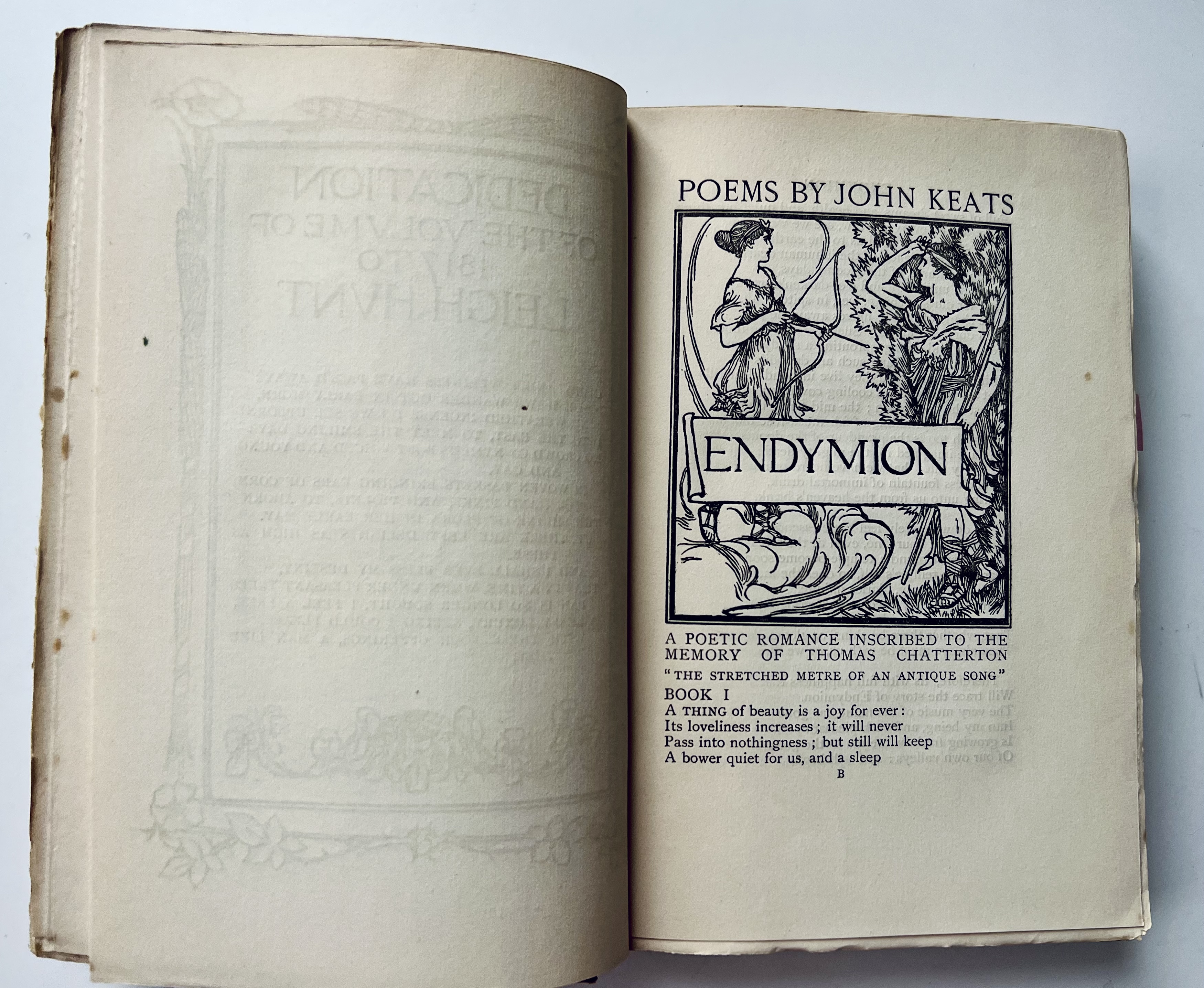 Front page of "Endymion" poem. Illustration by Robert Anning Bell.
Front page of "Endymion" poem. Illustration by Robert Anning Bell.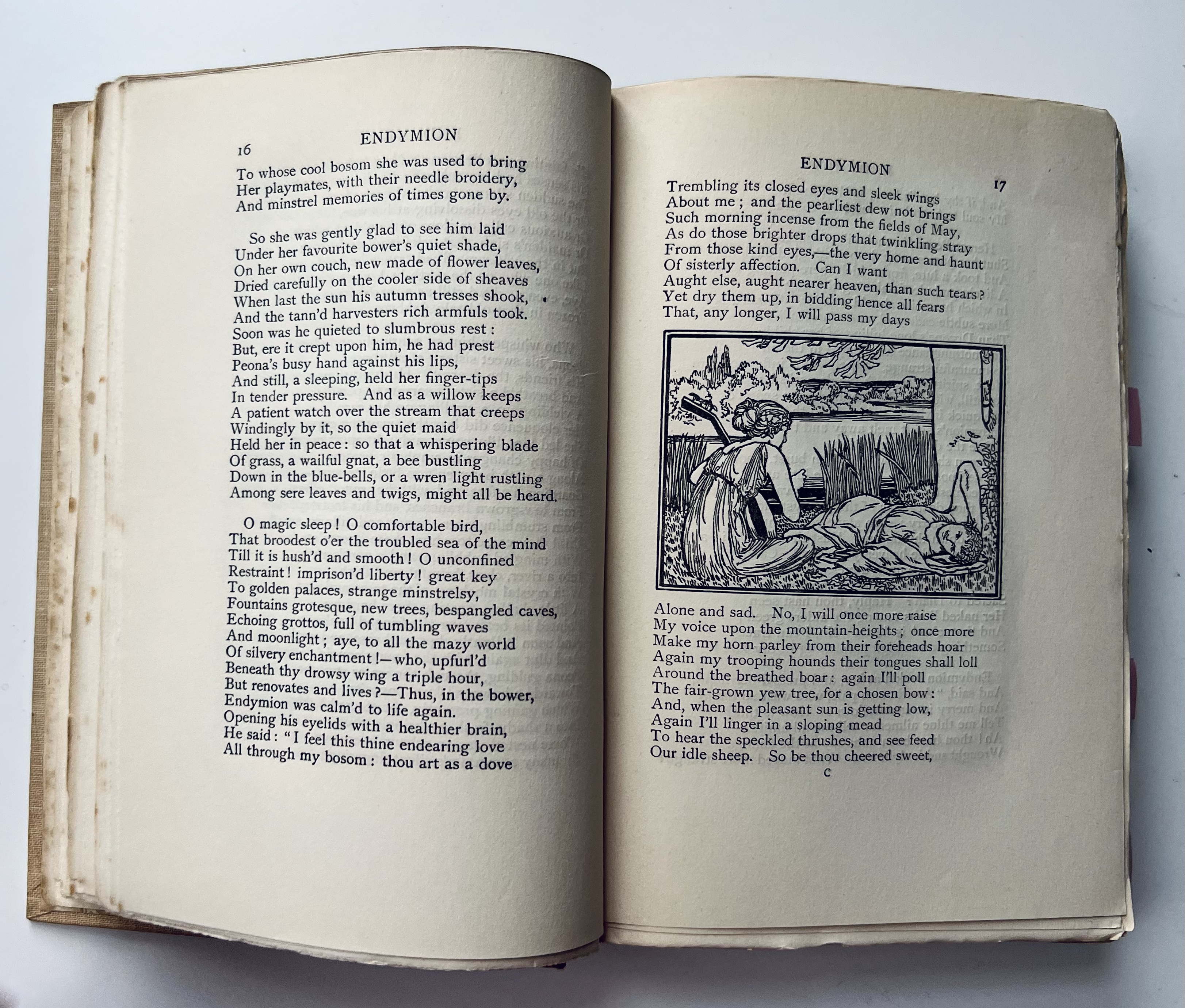 "Endymion." Illustration by Robert Anning Bell.
"Endymion." Illustration by Robert Anning Bell.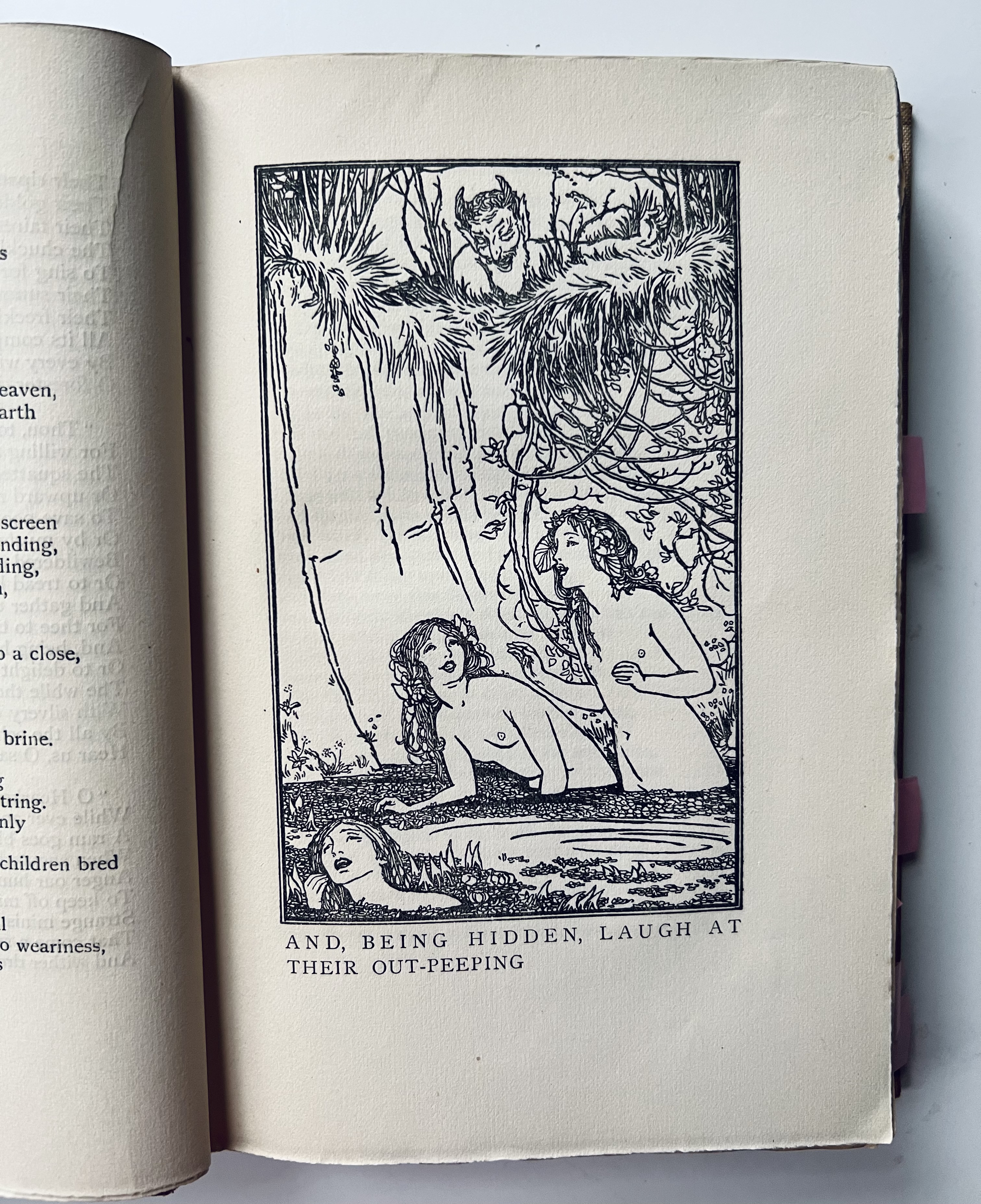 "And, being hidden, laugh at their out-peeping" from "Endymion." Illustration by Robert Anning Bell.
"And, being hidden, laugh at their out-peeping" from "Endymion." Illustration by Robert Anning Bell.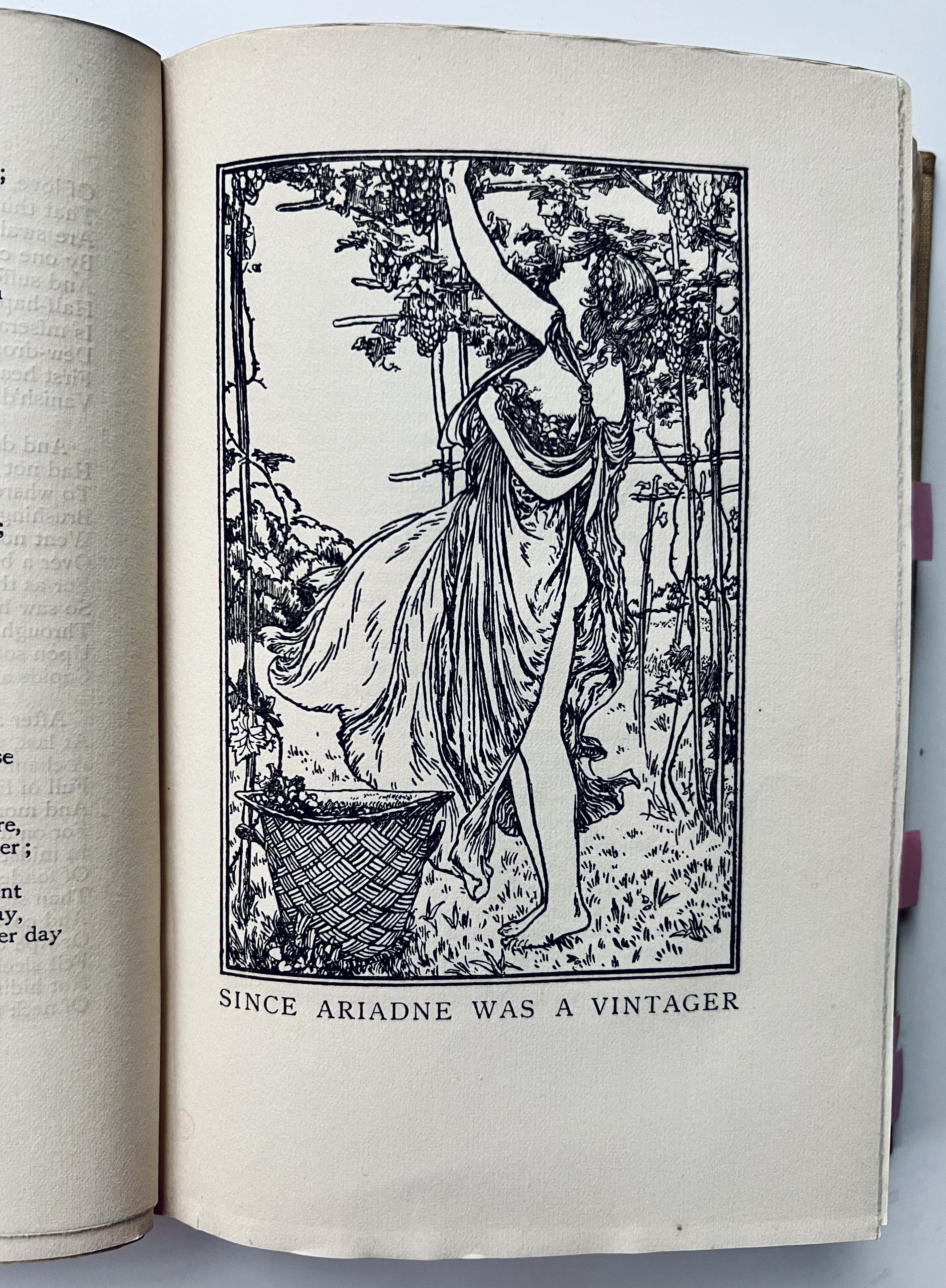 "Since Ariadne was a vintager / So cool a purple: taste these juicy pears..." from "Endymion." Illustration by Robert Anning Bell.
"Since Ariadne was a vintager / So cool a purple: taste these juicy pears..." from "Endymion." Illustration by Robert Anning Bell.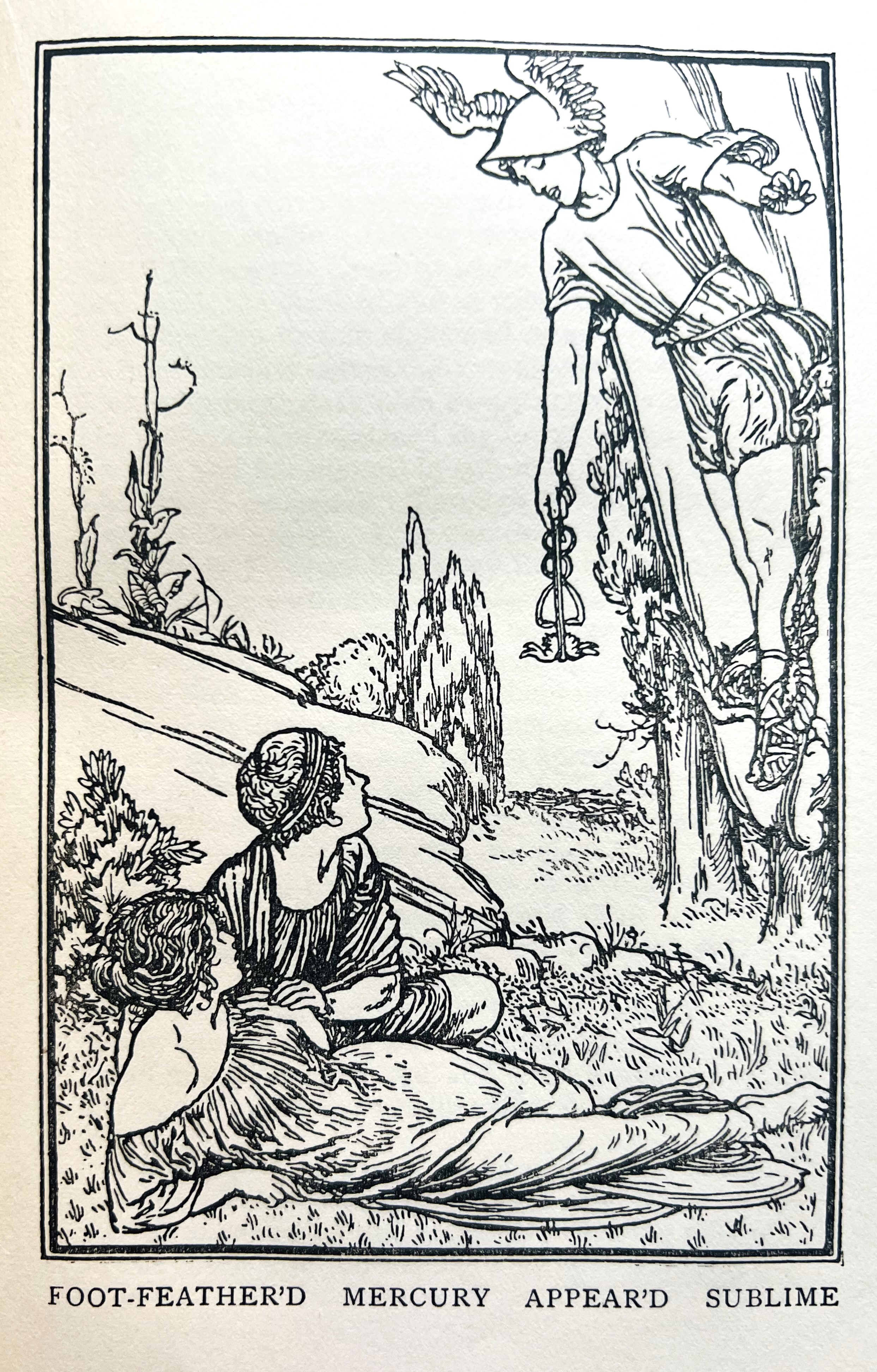 "Foot-feather'd Mercury appeared' sublime." From "Endymion." Illustration by Robert Anning Bell.
"Foot-feather'd Mercury appeared' sublime." From "Endymion." Illustration by Robert Anning Bell.In 1819, Keats, suffering from tuberculosis and aware it would likely claim his life, wrote and published a collection that contained the poems "The Eve of St. Agnes," "La Belle Dame sans Merci," "Hyperion," and "Lamia." Again, the response from critics was middling.
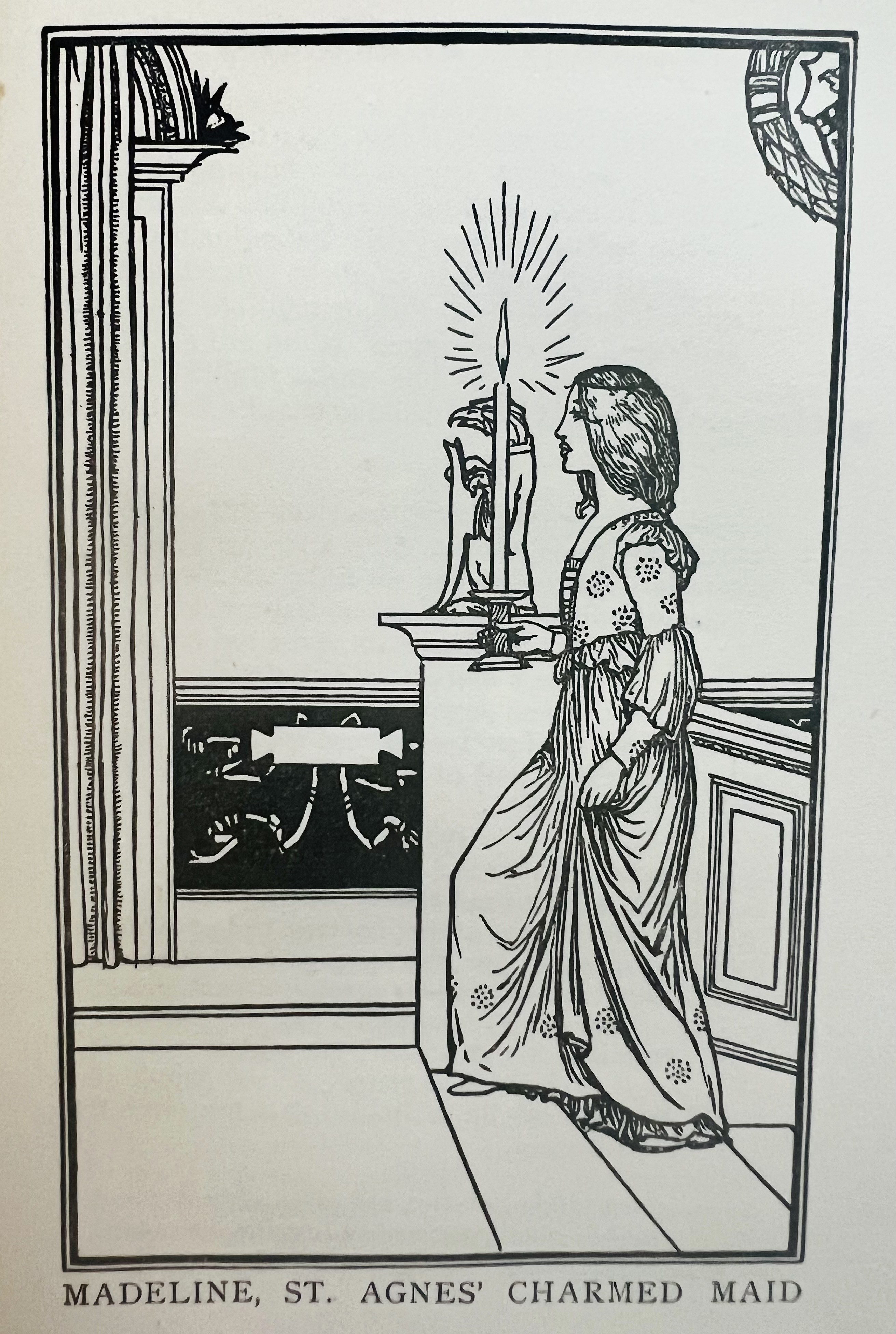 "Madeline, St. Agnes' charmed maid." from "The Eve of St. Agnes."
"Madeline, St. Agnes' charmed maid." from "The Eve of St. Agnes."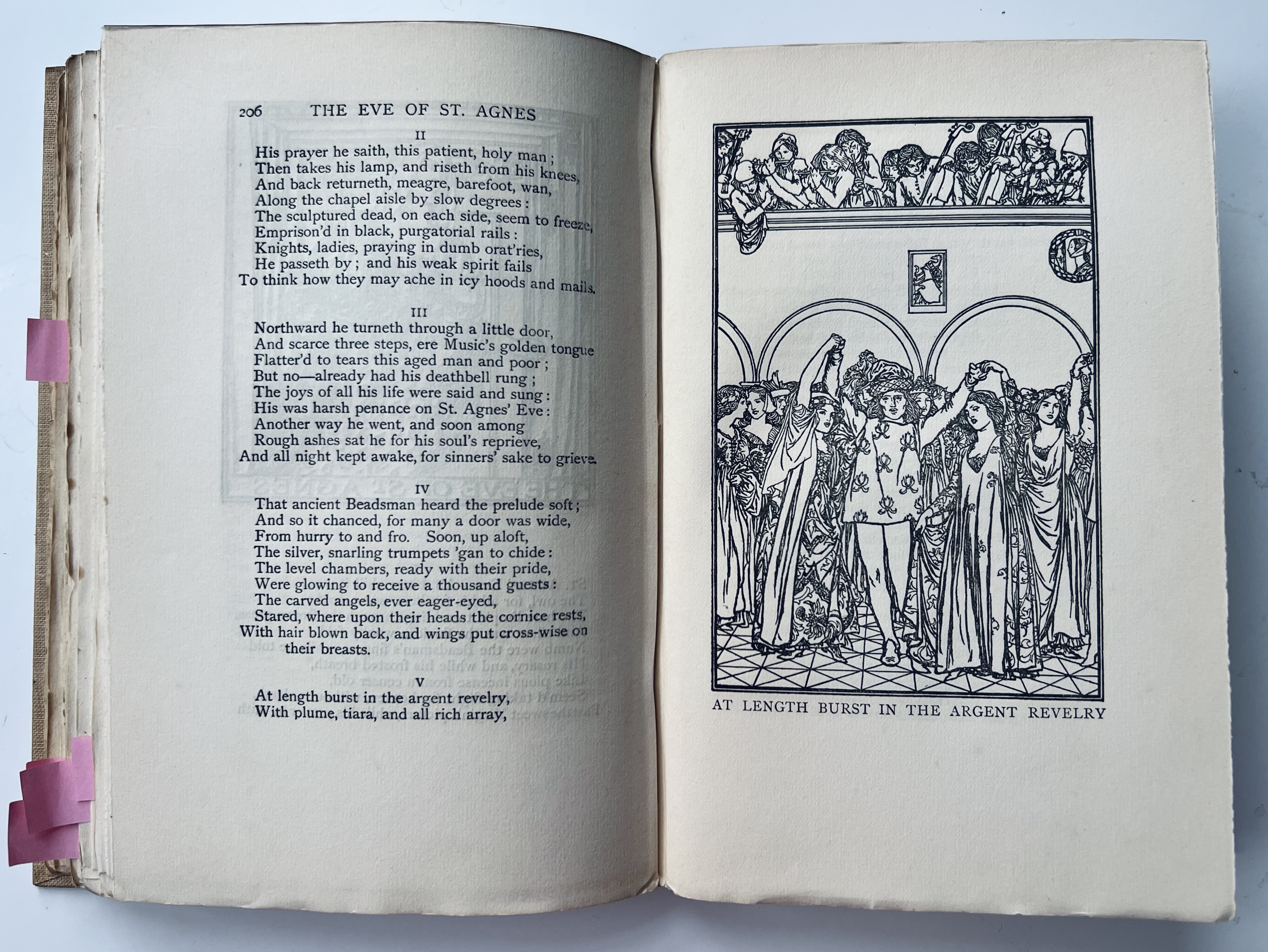 "At length burst in the argent revelry" from "The Eve of St. Agnes." Illustration by Robert Anning Bell.
"At length burst in the argent revelry" from "The Eve of St. Agnes." Illustration by Robert Anning Bell.There she stood
About a young bird's flutter from a wood,
Fair, on a sloping green of mossy tread
By a clear pool, wherein she passioned
To see herself escaped from so sore ills,
While her robes flaunted with the daffodils.From "Lamia"
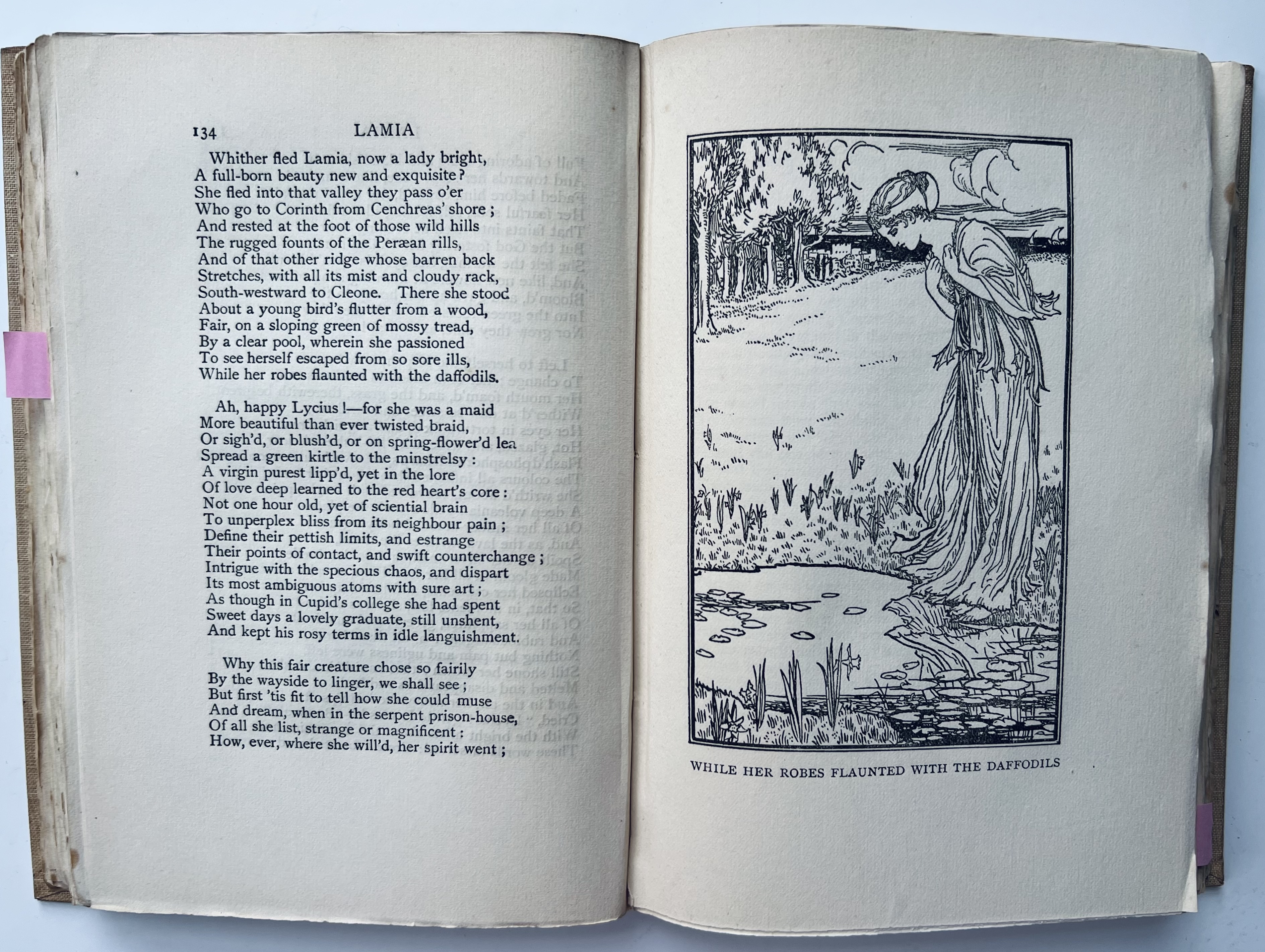 "With her robes flaunted with daffodils" from "Lamia" Illustration by Robert Anning Bell.
"With her robes flaunted with daffodils" from "Lamia" Illustration by Robert Anning Bell.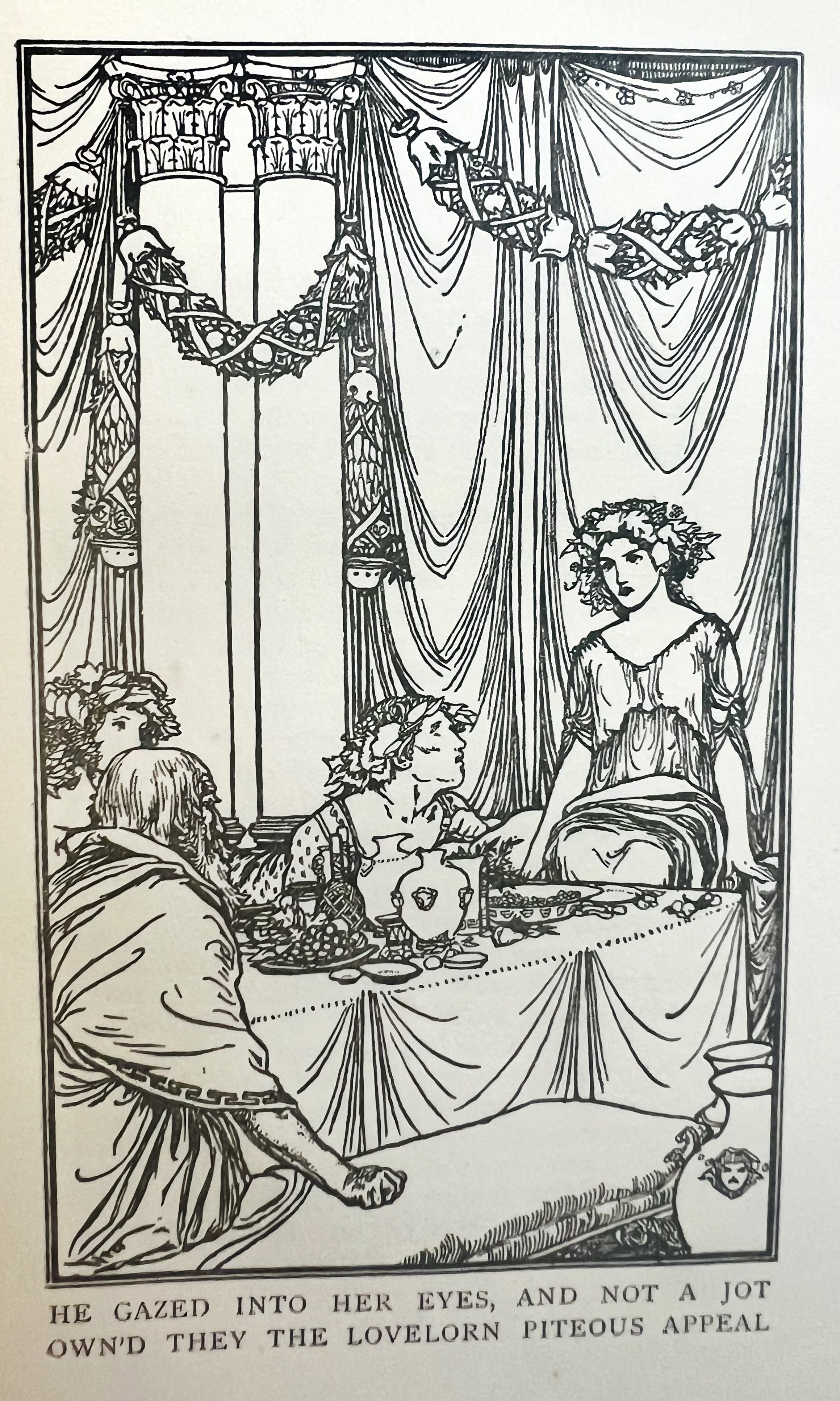 "He gazed into her eyes, and not a jot own'd they the lovelorn piteous appeal." from "Lamia." Illustration by Robert Anning Bell.
"He gazed into her eyes, and not a jot own'd they the lovelorn piteous appeal." from "Lamia." Illustration by Robert Anning Bell.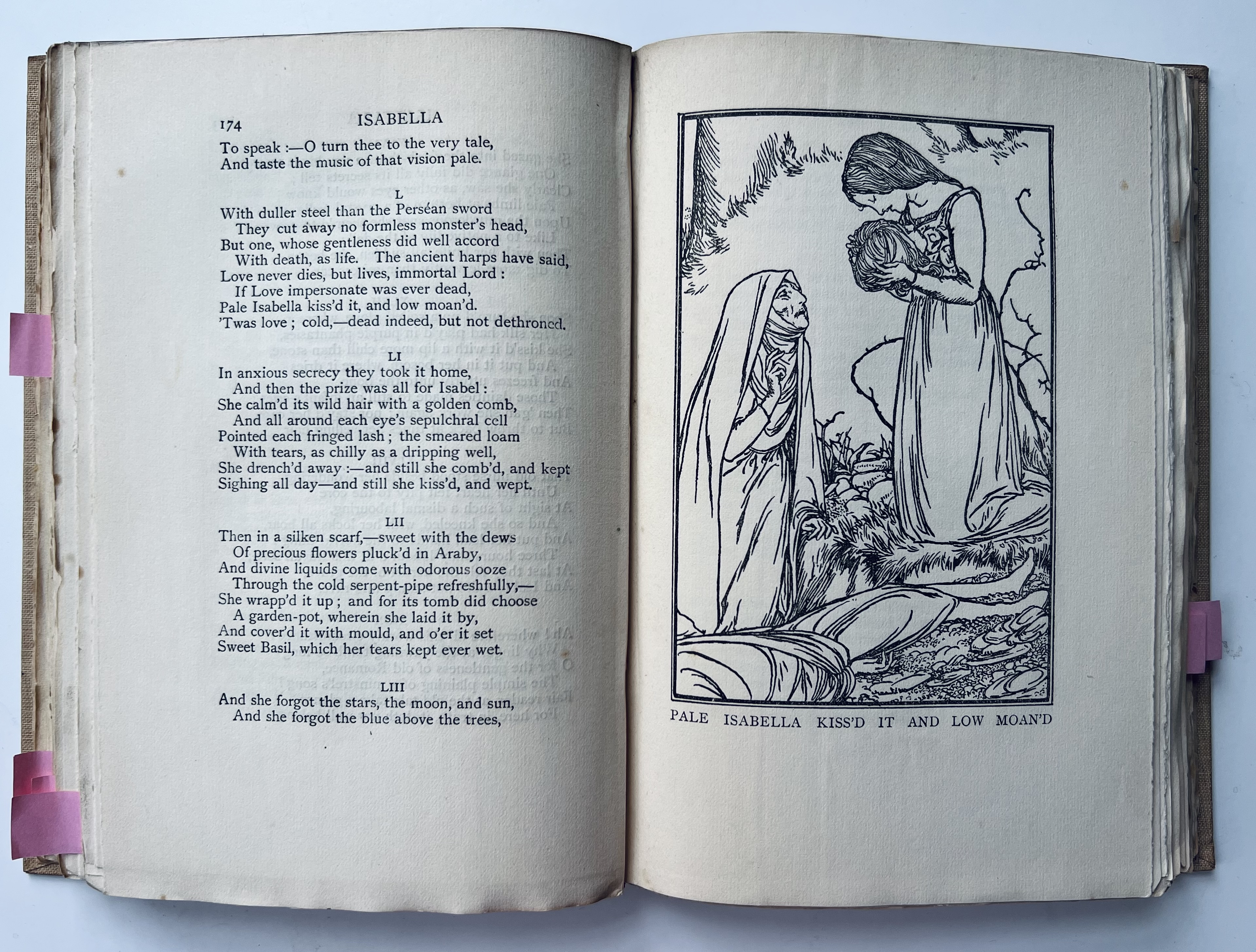 "Pale Isabella Kiss'd it and low moan'd" from "Isabella of the Pot of Basil." Illustration by Robert Anning Bell.
"Pale Isabella Kiss'd it and low moan'd" from "Isabella of the Pot of Basil." Illustration by Robert Anning Bell.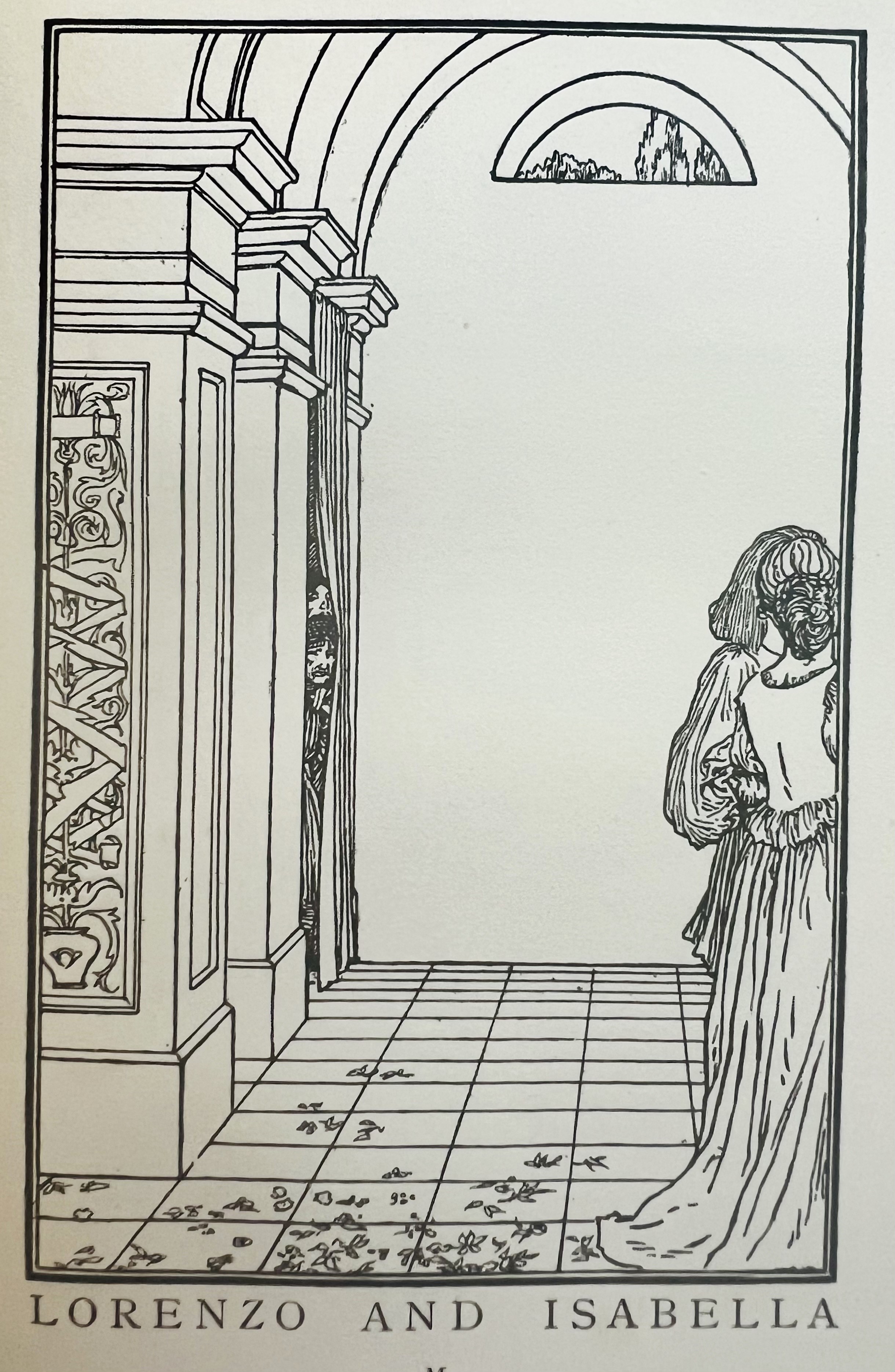 "Lorenzo and Isabella" from "Isabella of the Pot of Basil." Illustration by Robert Anning Bell.
"Lorenzo and Isabella" from "Isabella of the Pot of Basil." Illustration by Robert Anning Bell.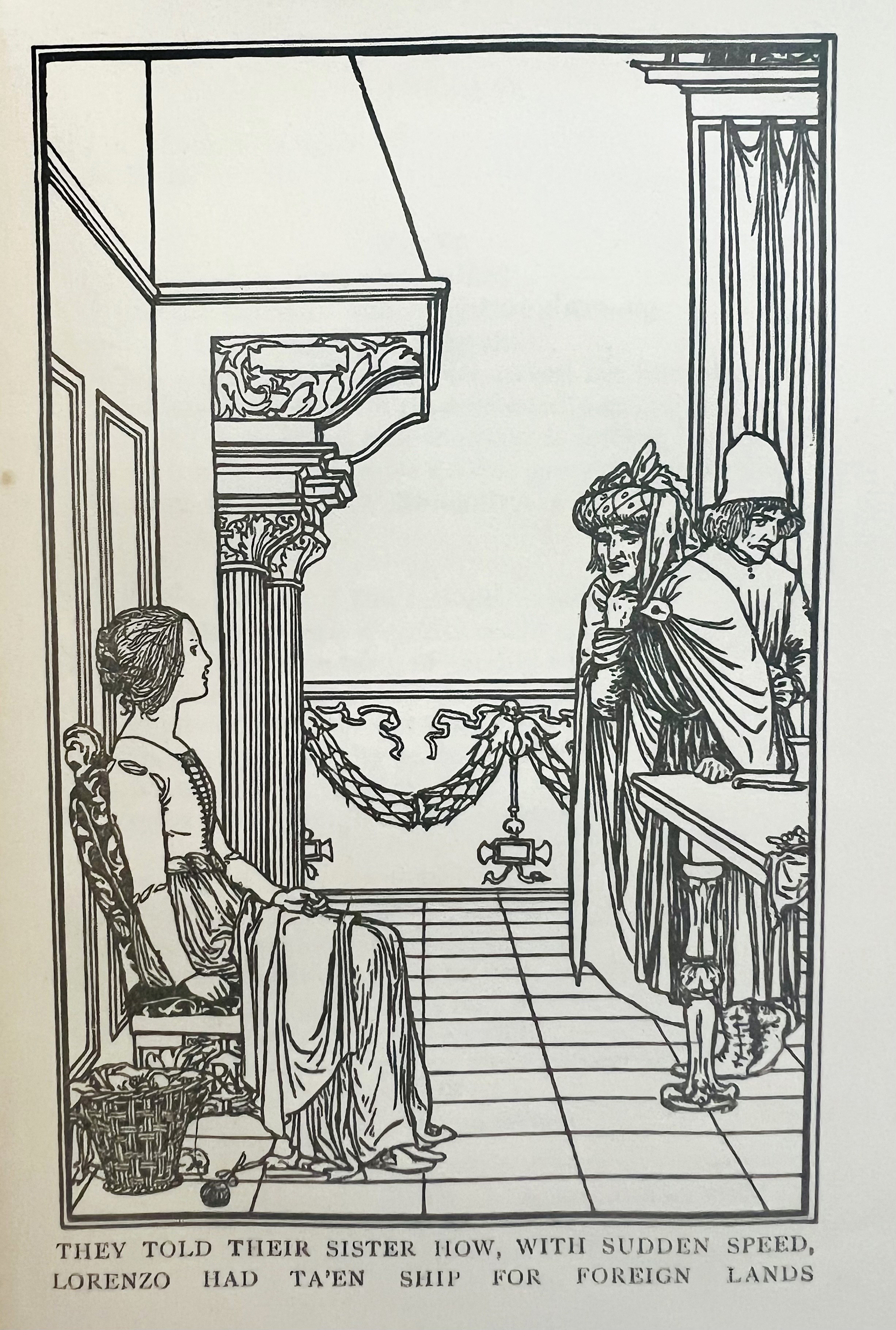 "They told their sister how, with sudden speed, Lorenzo had ta'en ship for foreign lands" from "Isabella or the Pot of Basil." Illustration by Robert Anning Bell.
"They told their sister how, with sudden speed, Lorenzo had ta'en ship for foreign lands" from "Isabella or the Pot of Basil." Illustration by Robert Anning Bell.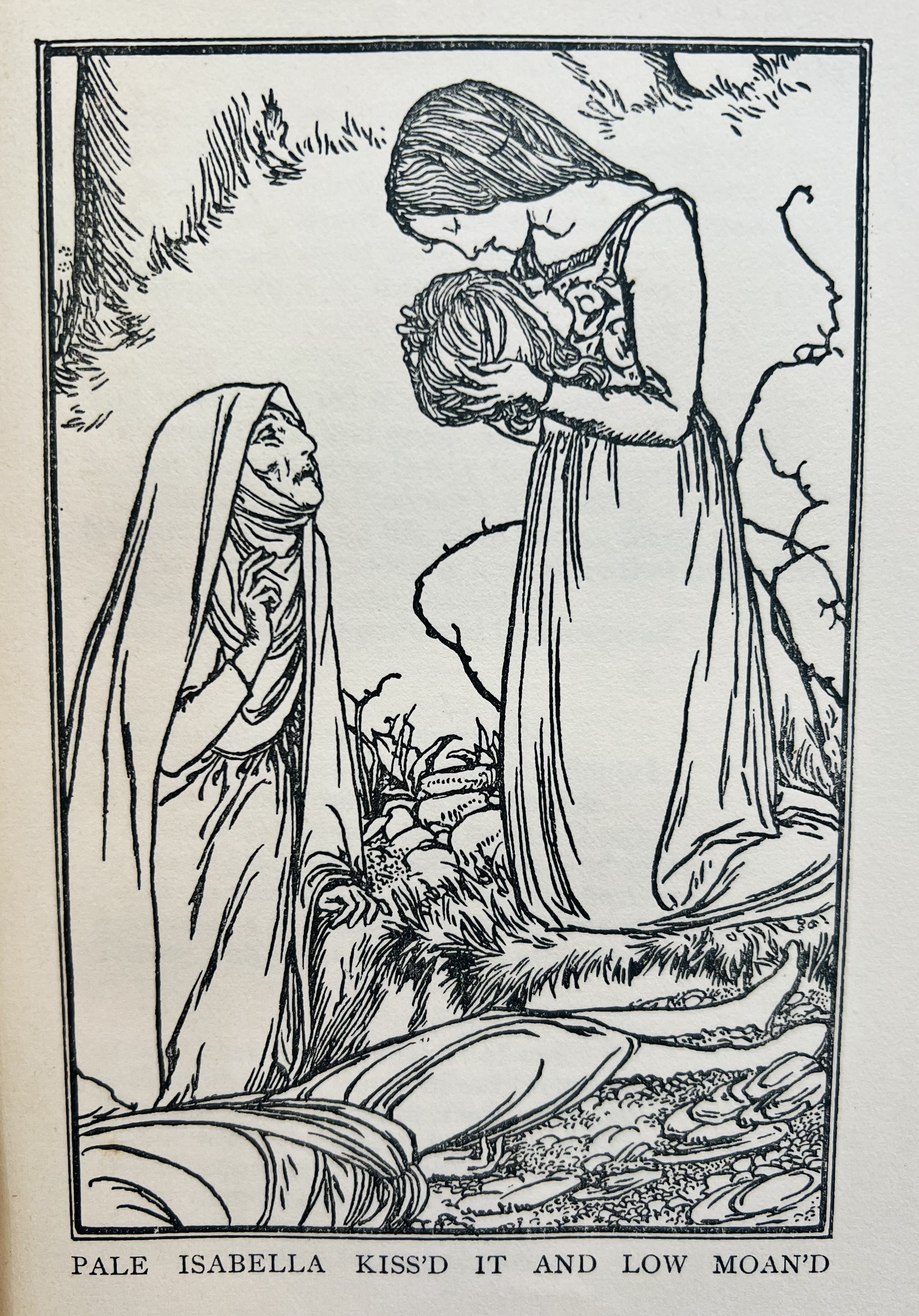 "Pale Isabella kiss'd it and low moan'd." from "Isabella." Illustration by Robert Anning Bell.
"Pale Isabella kiss'd it and low moan'd." from "Isabella." Illustration by Robert Anning Bell.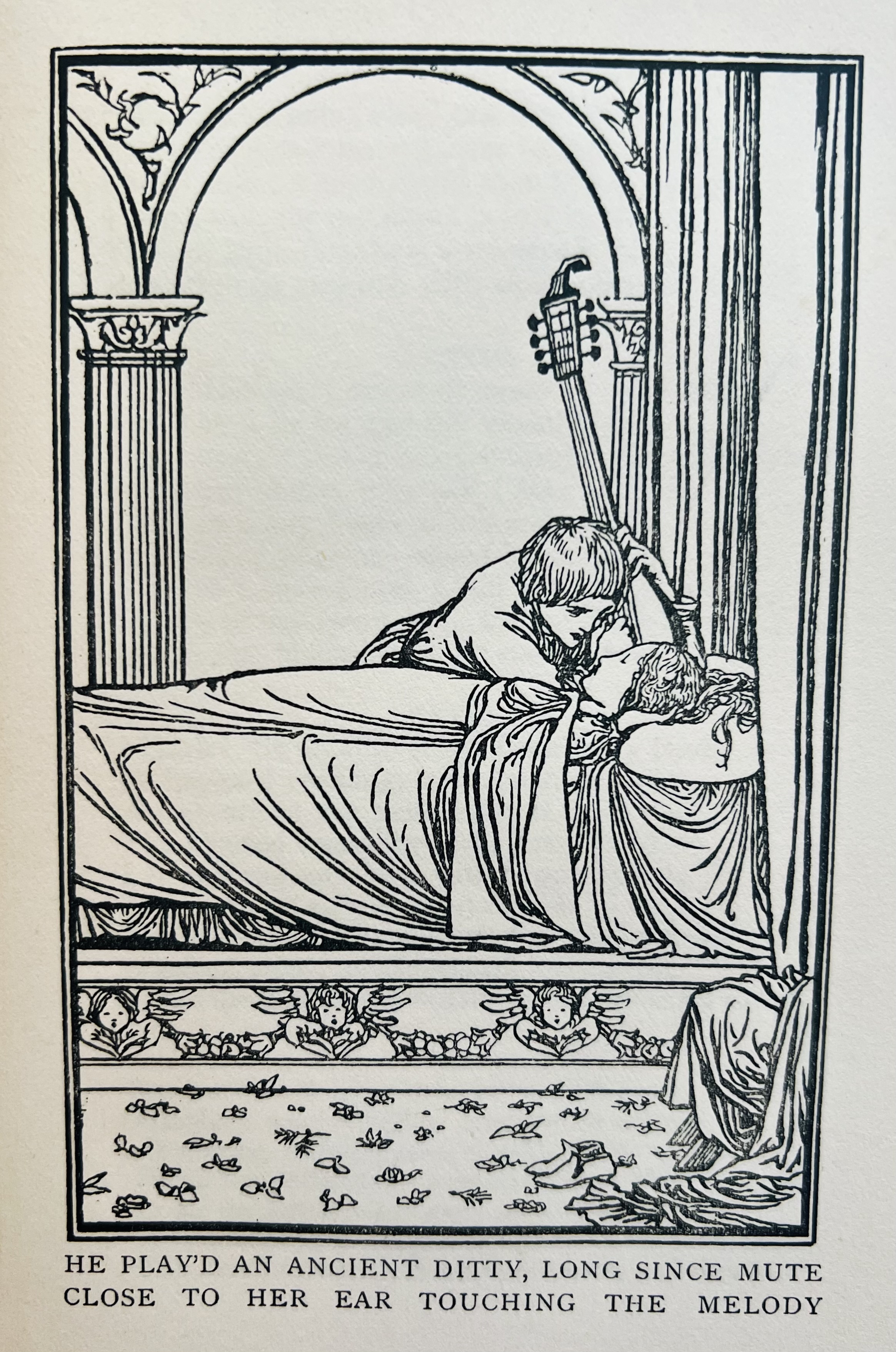 He play'd an ancient ditty, long since mute close to her ear touching the melody." from "The Eve of St. Agnes." Illustration by Robert Anning Bell.
He play'd an ancient ditty, long since mute close to her ear touching the melody." from "The Eve of St. Agnes." Illustration by Robert Anning Bell.Independently, in the spring of 1819, Keats wrote his five great Odes, including Ode on Melancholy, a sonnet-inspired piece that transcended emotion.
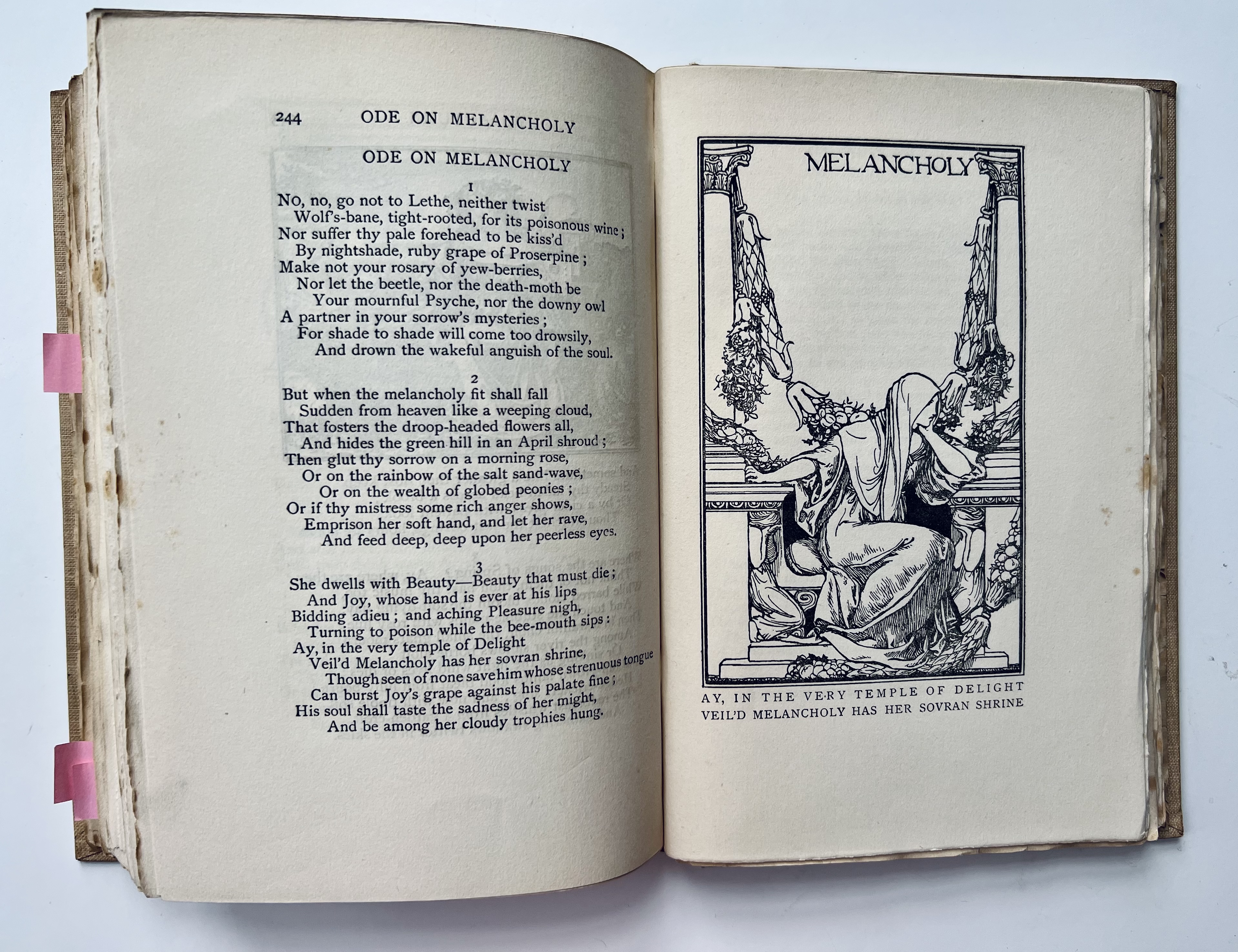 "Ay, in the very temple of delight veil'd melancholy has her sovran shrine." from "Ode on Melancholy."
"Ay, in the very temple of delight veil'd melancholy has her sovran shrine." from "Ode on Melancholy."And "Ode on Psyche."
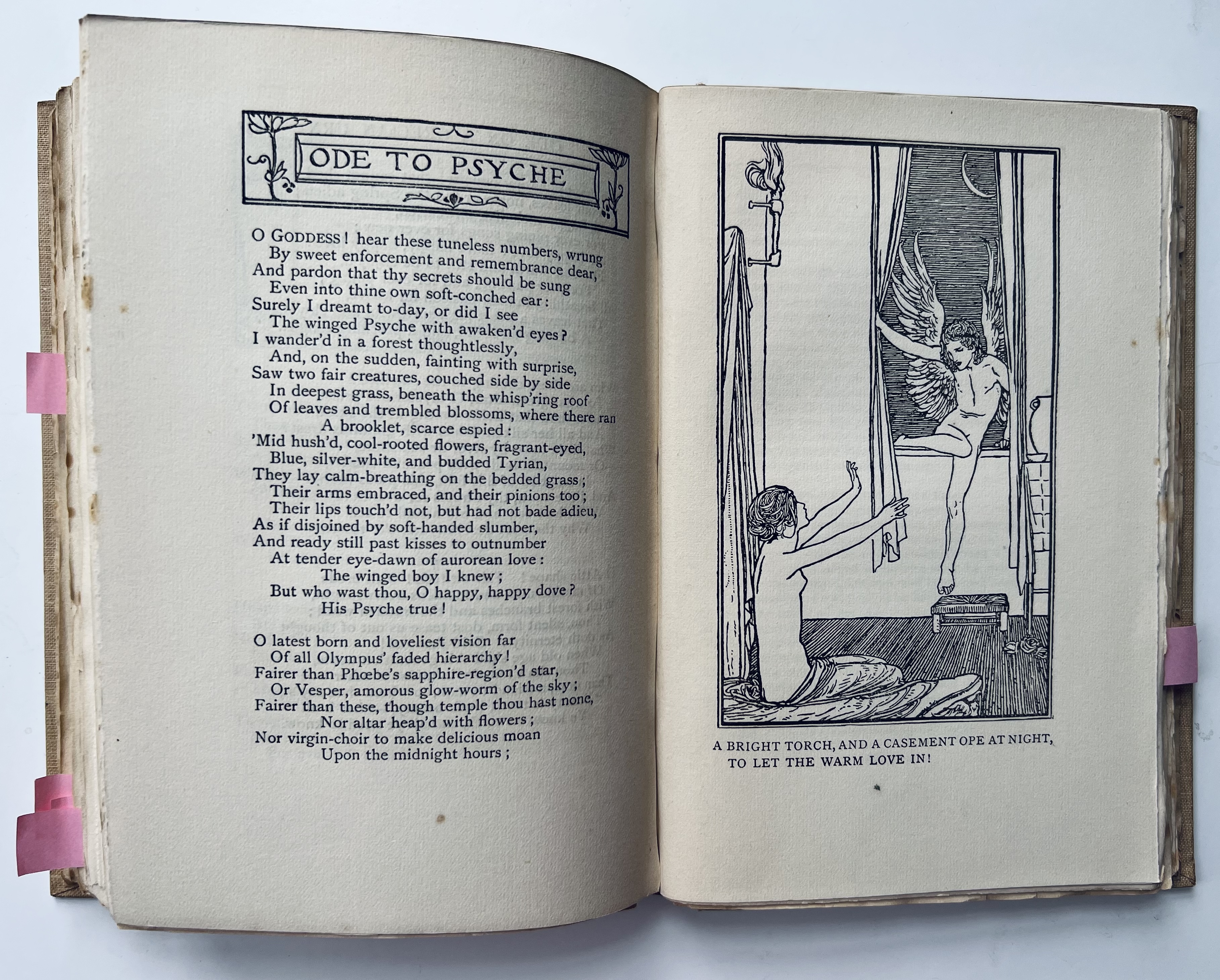 "A bright torch, and a casement ope at night, to let the warm love in!" From "Ode to Psyche." Illustration by Robert Anning Bell
"A bright torch, and a casement ope at night, to let the warm love in!" From "Ode to Psyche." Illustration by Robert Anning BellThat following autumn, while on a retreat west of London for health and financial reasons, Keats wrote (my personal favorite) "Ode on Autumn."
 "Ode to Autumn" illustration by Robert Anning Bell.
"Ode to Autumn" illustration by Robert Anning Bell.Keats died less than two years later, relatively unknown and generally uncelebrated, partly because he was so young and partly because his work, like that of all the Romantics, was considered radical during the post-Napoleonic Regency Period.
Percy Bysshe Shelley’s poem "Adonis" cemented Keats into posterity, comparing the young Keats to a tragic figure. (More tributes were written decades after his death; The Keats Letters Project has a thorough list). When the Victorian period began with Queen Victoria's coronation in 1838 and the subsequent mourning period for Prince Albert, Keats's letters were finally published, and readers were drawn to his heart-bearing confessions and astute observations.
Robert Anning Bell, a trained architect and artist, was quite well-known in London and was asked by the publishing house George Bell & Sons (no relation) to create these sumptuous illustrations for an 1897 print of Keats's poetry.
His style is late Arts & Crafts, an aesthetic that morphed into the more stylized Art Nouveau in the United States. Both presented nature-inspired lines and a more accessible design (think Gertrude Jekyll's wild cottage gardens), full of metaphors for independence, freedom, and its darker currents—danger and death.
How we wrangle the aesthetics of one time or another into our own is a profound statement of contemporary preferences. My childhood copies of Hermann Hesse's novels featured characters who just exited a disco hall because Hesse was wildly popular in the 1970s. Today, we love Rainer Maria Rilke, Wendell Berry, and Mary Oliver for embodying nature and gentle, maternal writings.
As you look at Bell's images, imagine them being viewed by Owen, T. S. Eliot, and Jorge Luis Borges, who adored Keats. How would the accompanying illustrations or photography change how you saw Keats' words? His life and persona? Who will we read and reinterpret two centuries from now? Who will we value and why?
As you contemplate, I leave you with this inscription from the book's previous owner. It might be my favorite thing about this altogether beautiful edition.
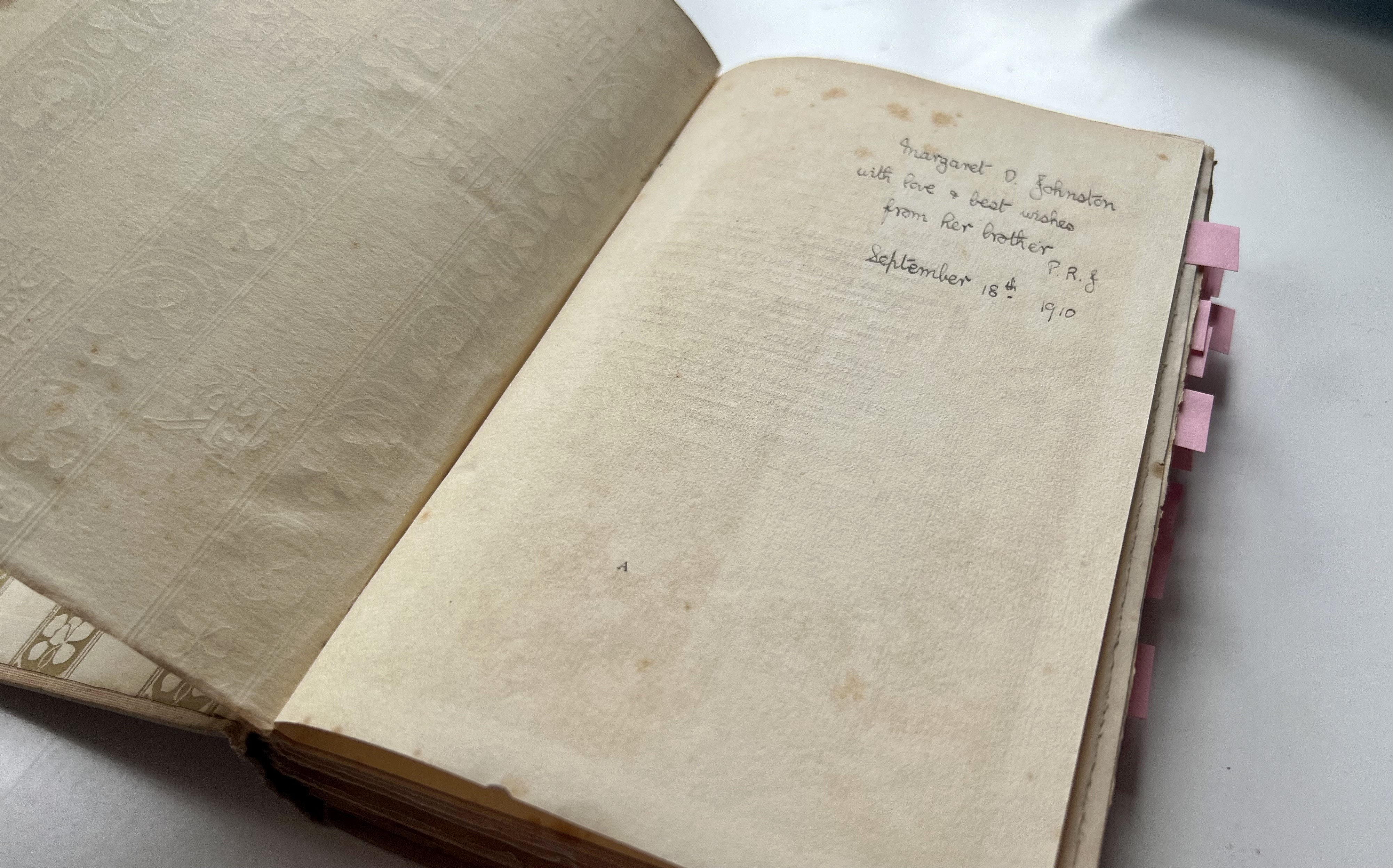 The inscription reads: "Margaret D. Johnston with love & best wishes from her brother, P. R. J., September 18th, 1910."
The inscription reads: "Margaret D. Johnston with love & best wishes from her brother, P. R. J., September 18th, 1910."

